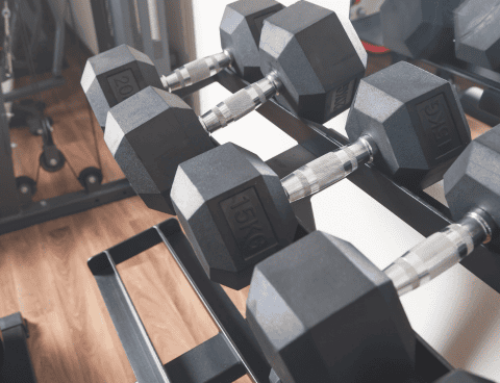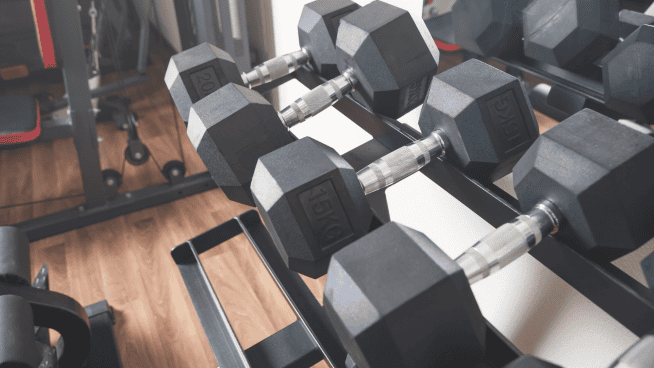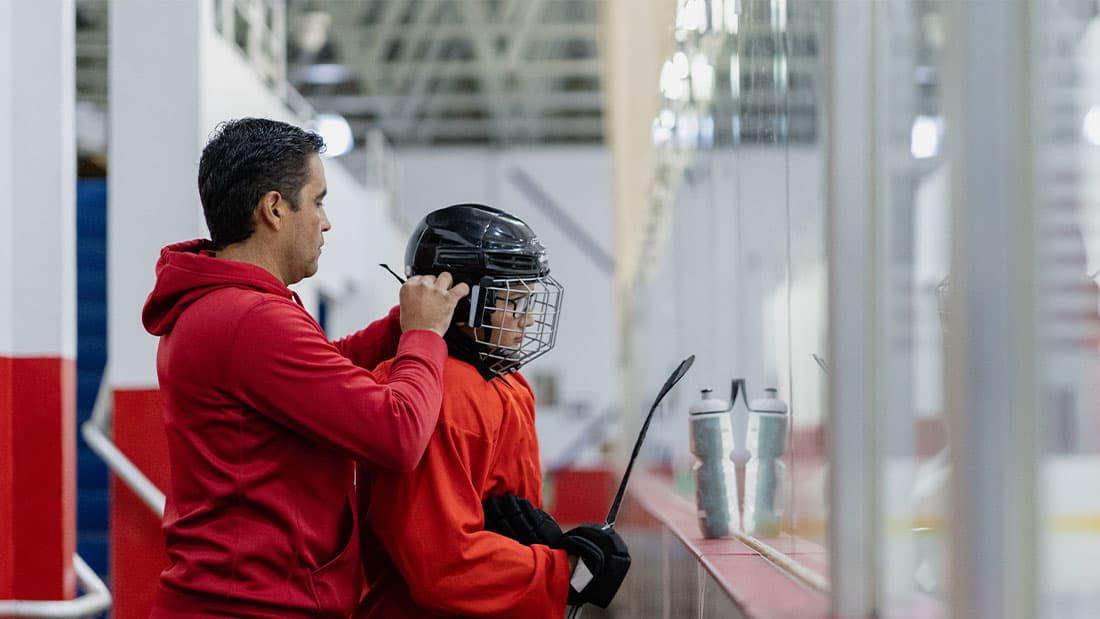Floor Press: The Forgotten Chest Builder
![]()
You cannot walk through a weight room without seeing at least one person on the Bench Press. It’s arguably the most popular free weight exercise. But its long-lost cousin, the Floor Press, seems to have been forgotten.
The Floor Press actually predates the Bench Press. People learned to bench a barbell off the floor before benches were even invented. The exercises are obviously similar. The primary difference is that the Floor Press is performed from, you guessed it, the floor.
Nowadays, the Floor Press is most commonly used by powerlifters and folks who are specifically seeking to improve their Bench Press strength. Besides that, it’s practically non-existent.
STACK is here to change your perception of the Floor Press. The exercise is good for more than improving your Bench Press. It is a solid upper-body pressing move that can help you gain strength, size and power. It’s also versatile, allowing you to bench with a barbell when no bench is in sight.
We spoke to Rick Scarpulla, owner of Ultimate Advantage Training (Bloomingburg, New York) and an expert on everything to do with the Bench Press, to learn more about the benefits of this exercise.
RELATED: Scarpulla’s Guide to a Bigger Bench Press
It’s Inherently Explosive
According to Scarpulla, the Floor Press is by nature an explosive exercise. When you lower the bar, your upper arms rest on the ground at the bottom of the movement. This removes tension and elastic energy from your muscles, whereas the bench in a Bench Press acts almost like a trampoline to help you drive the bar up off your chest.
With the Floor Press, you can’t rely on this elastic energy, so you basically start from scratch with each rep. Your muscles need to quickly turn on and produce speed and strength to drive the bar off the ground—and this is the definition of power.
“One of the most explosive things the human body is capable of is a transition from a negative energy transfer [when your arms rest on the ground] to a positive energy transfer [when you press the bar],” says Scarpulla.
It Develops the Triceps and Shoulders
Despite its shorter range of motion, the Floor Press won’t let you lift as much weight as you can on the Bench Press. When you lie on a bench, you can drive through the floor with your feet and gain power from your glutes. Neither is possible with the Floor Press, so your pressing muscles are forced to work harder.
The Floor Press develops the same muscles as the Bench Press—the pecs, triceps and anterior shoulder. However, the focus shifts primarily to the triceps and shoulders.
“It takes a lot of the back and chest out of the movement, because you stop when your arms are on the ground,” says Scarpulla. “When you go down, you’re not allowed to go through the back and activate the lat muscles. It’s a lot of tricep and front shoulder strength.”
This is not inherently a bad thing. Strong triceps are critical for any sports skill where you push an opponent away from you, such as a stiff arm or an offensive lineman pushing against a defensive lineman.
It Might Improve the Sticking Point on the Bench Press
The sticking point on the Bench Press occurs when you press the bar off your chest about halfway up. The Floor Press is primarily performed as a way to increase strength in this exact point. Although using the Floor Press for this purpose is effective to an extent, it’s not all it’s cracked up to be.
“While it does help with the sticking point, most times the sticking point is not a lack of strength but rather a lack of speed in the bottom portion of the bench,” explains Scarpulla. “The Floor Press is misinterpreted as exclusively a sticking point exercise. It’s more of a tricep and front delt builder than a sticking point exercise.”
If improving your sticking point is your goal, Scarpulla advises performing the Bench Press with a focus on bar speed.
It’s Easy on the Shoulder Joints
The limited range of motion of the Floor Press puts less stress on the shoulders. As your elbows move down during a typical Bench Press, you have the potential to put stress on your shoulders—although if you do the exercise correctly and have no pre-existing issues, this shouldn’t be a problem. But if you have finicky shoulders and still want to press, the Floor Press is a solid alternative.
RELATED: What To Do if You Experience Shoulder Pain on the Bench Press
How To Perform the Floor Press

How you perform the Floor Press depends on the equipment you have available, so we’ll present two options.
Option 1: Floor Press from a rack
Step 1: Position the bar on a squat rack about 2 feet off the ground.
Step 2: Lie on the floor under the bar with your knees bent. Hold the bar with a slightly-wider-than-shoulder-width grip.
Step 3: Lift the bar off the pins as if performing a standard Bench Press.
Step 4: Slowly lower the bar to your chest until your elbows touch the ground, keeping your upper arms at about a 45-degree angle to your body.
Step 5: Pause with your elbows on the ground for 2-3 seconds.
Step 6: Drive the bar over your chest until your arms are fully extended.
Step 7: Rack the bar when you finish the set.
Option 2: Floor Press without a rack
Step 1: Place a 45-pound plate or bumper plates on the bar (you need the full height).
Step 2: Sit on the ground and roll the bar over your legs until the center of the bar is over your hips. Lie back, bend your knees and place your feet flat on the ground
Step 3: Hold the bar with a slightly-wider-than-shoulder-width grip and position your elbows at a 45-degree angle to your body.
Step 4: Drive your hips up as if performing a Glute Bridge to shift the bar over your elbows. Your forearms should be perpendicular to the ground.
Step 5: Drive the bar over your chest until your arms are fully extended.
Step 6: Slowly lower the bar to your chest until your elbows touch the ground, keeping your upper arms at about a 45-degree angle to your body.
Step 7: Pause with your elbows on the ground for 2-3 seconds, then perform your next rep.
Step 8: When you finish the set, drop the bar over your lower stomach/upper hips where it started.
Note: Use this version only if you can easily slide the bar over your body.
RELATED: Score Higher on the Bench Press in Only 2 Weeks
RECOMMENDED FOR YOU
MOST POPULAR
Floor Press: The Forgotten Chest Builder
![]()
You cannot walk through a weight room without seeing at least one person on the Bench Press. It’s arguably the most popular free weight exercise. But its long-lost cousin, the Floor Press, seems to have been forgotten.
The Floor Press actually predates the Bench Press. People learned to bench a barbell off the floor before benches were even invented. The exercises are obviously similar. The primary difference is that the Floor Press is performed from, you guessed it, the floor.
Nowadays, the Floor Press is most commonly used by powerlifters and folks who are specifically seeking to improve their Bench Press strength. Besides that, it’s practically non-existent.
STACK is here to change your perception of the Floor Press. The exercise is good for more than improving your Bench Press. It is a solid upper-body pressing move that can help you gain strength, size and power. It’s also versatile, allowing you to bench with a barbell when no bench is in sight.
We spoke to Rick Scarpulla, owner of Ultimate Advantage Training (Bloomingburg, New York) and an expert on everything to do with the Bench Press, to learn more about the benefits of this exercise.
RELATED: Scarpulla’s Guide to a Bigger Bench Press
It’s Inherently Explosive
According to Scarpulla, the Floor Press is by nature an explosive exercise. When you lower the bar, your upper arms rest on the ground at the bottom of the movement. This removes tension and elastic energy from your muscles, whereas the bench in a Bench Press acts almost like a trampoline to help you drive the bar up off your chest.
With the Floor Press, you can’t rely on this elastic energy, so you basically start from scratch with each rep. Your muscles need to quickly turn on and produce speed and strength to drive the bar off the ground—and this is the definition of power.
“One of the most explosive things the human body is capable of is a transition from a negative energy transfer [when your arms rest on the ground] to a positive energy transfer [when you press the bar],” says Scarpulla.
It Develops the Triceps and Shoulders
Despite its shorter range of motion, the Floor Press won’t let you lift as much weight as you can on the Bench Press. When you lie on a bench, you can drive through the floor with your feet and gain power from your glutes. Neither is possible with the Floor Press, so your pressing muscles are forced to work harder.
The Floor Press develops the same muscles as the Bench Press—the pecs, triceps and anterior shoulder. However, the focus shifts primarily to the triceps and shoulders.
“It takes a lot of the back and chest out of the movement, because you stop when your arms are on the ground,” says Scarpulla. “When you go down, you’re not allowed to go through the back and activate the lat muscles. It’s a lot of tricep and front shoulder strength.”
This is not inherently a bad thing. Strong triceps are critical for any sports skill where you push an opponent away from you, such as a stiff arm or an offensive lineman pushing against a defensive lineman.
It Might Improve the Sticking Point on the Bench Press
The sticking point on the Bench Press occurs when you press the bar off your chest about halfway up. The Floor Press is primarily performed as a way to increase strength in this exact point. Although using the Floor Press for this purpose is effective to an extent, it’s not all it’s cracked up to be.
“While it does help with the sticking point, most times the sticking point is not a lack of strength but rather a lack of speed in the bottom portion of the bench,” explains Scarpulla. “The Floor Press is misinterpreted as exclusively a sticking point exercise. It’s more of a tricep and front delt builder than a sticking point exercise.”
If improving your sticking point is your goal, Scarpulla advises performing the Bench Press with a focus on bar speed.
It’s Easy on the Shoulder Joints
The limited range of motion of the Floor Press puts less stress on the shoulders. As your elbows move down during a typical Bench Press, you have the potential to put stress on your shoulders—although if you do the exercise correctly and have no pre-existing issues, this shouldn’t be a problem. But if you have finicky shoulders and still want to press, the Floor Press is a solid alternative.
RELATED: What To Do if You Experience Shoulder Pain on the Bench Press
How To Perform the Floor Press

How you perform the Floor Press depends on the equipment you have available, so we’ll present two options.
Option 1: Floor Press from a rack
Step 1: Position the bar on a squat rack about 2 feet off the ground.
Step 2: Lie on the floor under the bar with your knees bent. Hold the bar with a slightly-wider-than-shoulder-width grip.
Step 3: Lift the bar off the pins as if performing a standard Bench Press.
Step 4: Slowly lower the bar to your chest until your elbows touch the ground, keeping your upper arms at about a 45-degree angle to your body.
Step 5: Pause with your elbows on the ground for 2-3 seconds.
Step 6: Drive the bar over your chest until your arms are fully extended.
Step 7: Rack the bar when you finish the set.
Option 2: Floor Press without a rack
Step 1: Place a 45-pound plate or bumper plates on the bar (you need the full height).
Step 2: Sit on the ground and roll the bar over your legs until the center of the bar is over your hips. Lie back, bend your knees and place your feet flat on the ground
Step 3: Hold the bar with a slightly-wider-than-shoulder-width grip and position your elbows at a 45-degree angle to your body.
Step 4: Drive your hips up as if performing a Glute Bridge to shift the bar over your elbows. Your forearms should be perpendicular to the ground.
Step 5: Drive the bar over your chest until your arms are fully extended.
Step 6: Slowly lower the bar to your chest until your elbows touch the ground, keeping your upper arms at about a 45-degree angle to your body.
Step 7: Pause with your elbows on the ground for 2-3 seconds, then perform your next rep.
Step 8: When you finish the set, drop the bar over your lower stomach/upper hips where it started.
Note: Use this version only if you can easily slide the bar over your body.











